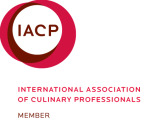The focus of the second class in Chocolate 201: Pralus.
Last week highlighted Patric Chocolate, which was a great way to open the series. It was such a study in small-batch chocolate, a limited product line, and attention paid to every single detail. I think it’s safe to say that everyone in the room really liked each of the chocolates that we tasted.
Tonight was a mixed bag, with some people liking one chocolate while others disliking the same one. I will say that I have less of an emotional attachment to Pralus, having not met the chocolate maker, but that I respect the company for what it did for artisan chocolate. Pralus is probably best known for its 100% Madagascar bar (typically the best-seller in any shop that sells bean-to-bar chocolate) and for its tasting pyramid. The tasting pyramid features 10 of the single-origin chocolates from the Pralus line, complete with tasting notes. It was really the first marketing campaign that really pushed the idea of how different chocolate can be, based on where it’s from. I’d argue that there’s more to flavour and texture than just origin, but that’s fodder for a much longer post.
Anyway, tonight was a chocolate extravaganza. We tasted six selections from Pralus, and then an assortment of Ecuadorian chocolates that I brought from my personal collection. Finished off with some wackiness from Zotter and a shot of drinking chocolate, it’s safe to say that people left the class chock full of chocolate.
Pralus Venezuela 75%
This bar had some pretty characteristic Pralus quirks: exceptional smoothness and meltiness, due to the addition of extra cocoa butter. This bar had notes of butter and caramel, with just a hint of licorice in it. Last week, we tasted the Rio Caraibe bar from Patric Chocolate, which is also from Venezuela, and the two bars couldn’t be more different. It’s an interesting exercise in showing that bean origin is only one factor; the personality and preferences of the chocolatemaker also have a lot to do with it.
Pralus Madagascar 100%
We jumped right into things and tasted the 100% bar. We compared it to another 100% bar, which was astringent, tannic and bitter. In comparison, the Pralus bar is surprisingly sweet, with definite red fruit and red wine characteristics. It’s certainly not bitter, though it does take some getting used to. And, of course, the characteristic Pralus smoothness of the bar helps its palatability.
Pralus Madagascar 75%
This bar is a single-origin bar from Madagascar, and while it has the red fruit you’d expect for a bar from Madagascar, it isn’t as prominent as with other Madagascan chocolate. You have to look for it a little bit, but it’s there–accompanied with pleasant acidity and brightness, and just a hint of citrus. Again, as a comparison with the Patric Madagascar bar from last week, the Pralus is much more muted and less effusive.
Pralus Tanzania 75%
This one was an interesting study in the flavour of toast. Toast is a tricky one to master, as it can be pleasant to some people or just taste burnt to others. I think the roast on this bar is dangerously close to burnt, though it just manages to come across as toasted almond with a bit of smoke. I think some people in the class found it closer to burnt.
Pralus Ecuador 75%
Ecuador lays claim to its own genetic strain of chocolate, the Arriba Nacional strain. Others think that it’s just a genetic variation of Forastero beans. Either way, these beans are known for brash tropical fruitiness, with banana and citrus being common flavours. This bar elicited a lot of suggestions from the group, including figs, raisins and coconut. There were also suggestions of the bitterness of matcha tea (bitter, but in a savoury kind of way), and tobacco. One person astutely noted that the flavours in this chocolate are quite light–like the flute section in an orchestra–lacking middle or underlying flavours.
Pralus Fortissima 80%
The Fortissima is a blend of various beans, with a decided raisin aroma. It’s marked by acidity, a slight bitterness, and the sensation of spice. People in the class tasted butterscotch, coffee and toffee. If the Ecuador bar is the flute section of the orchestra, the Fortissima is the double bass, or perhaps the French horn: deeper tones, more brooding.
Republica del Cacao La Communidad Vinces 75% and Esmereldas 75%
The bar from La Communidad Vinces is the first certified organic bar from Republica del Cacao, who are a lovely little company in Ecuador. This one has some vague tropical fruit, though I taste a bit of a hay undertone to it. The Esmereldas bar is a bit hesitant, too, and the class had difficulty finding the purported lemon zest notes that are in it. I do love the company and think they’re doing great things, but have found some of the batches to vary widely. I’m crossing my fingers and hoping that they come up with a consistently good product, because I’d like to see them do well.
Askinosie San Jose del Tambo, Ecuador 70% and White Chocolate Nibble Bar
I really wish that Xoxolat carried Askinosie, because then I would have made Chocolate 201 into a five-part series and highlighted this great company from Springfield, MO. Whether it’s the picture of the farmer on the package, the lot number that lets you trace its origin, the innovative sustainable packaging, or the great story about the chocolatemaker, this is a fun product to talk about. The Ecuador 70% tastes distinctly like banana, with a pleasant toastiness to it. The white chocolate nibble bar–what I like to think of as a deconstructed cacao bean, with the cocoa nibs embedded in white chocolate–is slightly too sweet and a bit granular, but the shock of goat’s milk is really quite fun.
We capped off the evening with a selection of Zotter bars (beer, champagne, blood orange) and Xoxolat’s famous West Coast Breakfast Bar, featuring maple, double-smoked bacon and espresso. Breakfast for dinner never tasted so good.
I think everyone is looking forward to next week’s chocolate and whiskey extravaganza. I can’t think of a nicer pairing: the shocking flavours of Amano Artisan Chocolate, plus a crash course in smoky Islay scotches with Marcus von Albrecht.



Pingback: Chocolate 201: Amano Chocolate recap (plus scotch) « The Well-Tempered Chocolatier
Pingback: Chocolate 201: Recap « The Well-Tempered Chocolatier
I love your blog I just discovered, that’s why I’m commenting here an old post. Where do you buy Pralus chocolate ? Do you know if it’s easy to find some in Montreal ? (I haven’t tasted this pyramid for such a while…) Thanks!
Hi Jude, thanks for stopping by. Apologies for the delay, as I’m not familiar with chocolate sources in Montreal. However, a friend of mine recommends checking out Le Cartet, Folie en Vrac (Mont-Royal) or La Vielle Europe (St-Laurent). Let me know what you turn up! e.
Hi ! I found some at Gourmet Laurier. They have a great selection of Michel Cluizel, Valrhona, Pralus bars… even some Amedei Porcelana. They didn’t have Pralus’ pyramid but I tasted a few amazing bars !
Hi Jude,
Thanks for the update, and glad that you had success. Mmmm, Amedei Porcelana…
e.